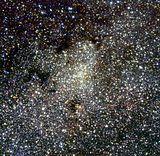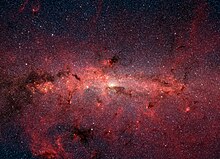Galactic center

The galactic center is the barycenter of the Milky Way . Seen from earth , it is in the constellation Sagittarius , where the visible band of the Milky Way appears most densely ( right ascension α = 17 h 46 m and declination δ = −29 ° 00 ′). The galactic center contains the supermassive black hole Sagittarius A * with a mass of 4.1 million solar masses . The alignment of the galactic coordinate system is (for historical reasons only approximately) determined by the position of the galactic center (galactic longitude is ≈0 °), but for practical reasons the zero point of the galactic coordinate system is the sun. At 8.12 kpc, the galactic center is close enough to Earth that the movements of individual stars can be examined.
In the constellation Fuhrmann , directly opposite the galactic center, lies the region of the galactic disk with the lowest observable star density - the galactic anticenter .
Hidden behind dark clouds

The constellation Sagittarius ( Latin sagittarius ) contains a particularly large number of stars and nebulae , but the galactic center itself can not be observed in visible light , as dark dust clouds of interstellar matter on the way to Earth increase it by around 30 magnitudes (factor 10 12 ) is weakened.
With longer-wave radiation ( infrared and radio waves ) as well as in the hard X-ray range , however, observations are possible, since these areas of the electromagnetic spectrum penetrate dust much better.
In addition, the galactic center is the center of the galactic rotation of all bodies in the Milky Way system and as such can be accessed indirectly.
Radio, infrared and X-ray radiation
Even at the beginning of the development of radio astronomy , Karl Guthe Jansky succeeded in 1931 in detecting radio emissions from the direction of the galactic center. Later observations resolved this emission into various radio sources of different nature. One of these sources, Sagittarius A (West) , is an approximately spiral-shaped structure of ionized gas about 2 pc in size. It is surrounded by a ring of colder molecular interstellar matter . Within Sagittarius A is the compact radio source Sagittarius A * . This source at α = 17 h 45 m 40 s , 04 and δ = −29 ° 00 ′ 28 ″, 2 ( J2000.0 ) lies in the center of the Milky Way.
Since the 1960s, as infrared astronomy continued to develop, the galactic center became one of its preferred destinations. A star cluster S-star cluster became increasingly dense towards the inside , the center of which is at Sagittarius A *. Surprisingly, many stars in the innermost 0.5 pc are young, hot stars. It is not yet fully understood how they came into being under the extreme conditions there or how they got there during their lifespan of just a few million years.
Towards the end of the 1990s, images from the Chandra X-ray satellite were also able to detect X-rays from Sagittarius A * for the first time. Earlier X-ray telescopes had already detected emissions from the area of the galactic center, but their assignment was not clear due to poor angular resolution .
Central black hole
→ Main article: Sagittarius A *
In astronomy, supermassive black holes are widely accepted as an energy source for active galactic nuclei and are now believed to be in the nucleus of every bright elliptical galaxy and every bulge of a spiral galaxy . At least in individual cases, direct evidence of the gravitational effect of the black hole is necessary in a way that excludes other explanations. The galactic center offers what is probably the strongest evidence today.
The properties of the strong radio source Sagittarius A * in the center of the Milky Way system suggest that it is a sign of a black hole. Sgr A * radiates very brightly from a very small area, which cannot be explained by other types of radio sources. But this evidence is still indirect. The small proper movement of Sgr A * - essentially you only see the reflection of the sun's orbit around the galactic center - indicates a very massive object. A low-mass object, like the stars in the central cluster, should move very quickly in the sky unless it happens to be moving precisely towards the sun.
The best evidence of a black hole comes from the movement of matter under the influence of its gravity. As early as the late 1970s, Charles H. Townes and co-workers had detected rapid gas movements in the galactic center, but there were still some doubts here, since gas can also be subject to forces other than gravity (for example from magnetic fields or stellar winds ), and spatial ones Resolution not fully sufficient. Since the 1990s, German and American research groups have therefore been investigating the movement of the stars in the central star cluster with ever higher spatial resolution. To correct the air turbulence , first speckle interferometry and then adaptive optics were used. The increase in the speed of movement of the stars in the vicinity of the central mass could thus be followed to a distance of less than 0.1 arc seconds . Astronomers at the Max Planck Institute for Extraterrestrial Physics were able to determine the mass of this black hole with a relatively high degree of accuracy at around 4.31 million solar masses . Ways other than a black hole to pack so much mass into such a small volume would not be stable over the age of the Milky Way.
Since 2001, bursts of brightness of typically one to a few hours in the immediate vicinity of the black hole have repeatedly been observed in the X-ray and infrared range. Their short-term flickering may contain information about space-time if they are only a few Schwarzschild radii away from the black hole .
Astronomers have had their sights on a particular star S2 of Sagittarius for decades, tracking two-thirds of its full orbital around the galactic center. No object had previously been observed so close to the center of a galaxy for such a long period, nor had any other object been discovered that could be observed for more than a small portion of its full orbit around the center of the galaxy. Rainer Schoedel from the Max Planck Institute for Extraterrestrial Physics sees these research results as evidence of a supermassive black hole.
In 2011, astronomers at the Max Planck Institute for Extraterrestrial Physics examined images of the Milky Way center in the range of 3.8 micrometers wavelength. They discovered a gas cloud G2 , which was moving towards the central black hole and was being torn apart by the tidal forces . It was assumed that parts of the gas would be slowed down within the following years, sucked in by the force of gravity of the black hole and then disappear behind its event horizon. However, this was not observed, nor was the expected radiation release. Instead, the gas cloud flew on in a strongly elliptical orbit.
gallery
literature
- Sascha Trippe: Ten thousand stars and one black hole. A study of the galactic center in the near infrared. Harland Media, Lichtenberg 2008, ISBN 978-3-938363-22-5 . (Also: Univ., Diss., Munich 2008).
- Fulvio Melia: The black hole at the center of our galaxy. Princeton University Press, Princeton NJ et al. 2003, ISBN 0-691-09505-1 .
- Fulvio Melia: The galactic supermassive black hole. Princeton University Press, Princeton NJ et al. 2007, ISBN 978-0-691-09535-6 .
- Roland Gredel: The Galactic Center. 4th ESO / CTIO workshop. La Serena, Chile, March 10-15, 1996. Astronomical Society of the Pacific, San Francisco CA 1996, ISBN 1-886733-22-8 . ( Astronomical Society of the Pacific Conference Series 102)
Web links
- Galactic Center - side at the Max Planck Institute for Extraterrestrial Physics (English)
- Press release from the Max Planck Institute for Extraterrestrial Physics
- The labeled Galactic Center - Astronomy Picture of the Day, August 31, 2010.
Videos
- Are there black holes in the Milky Way? from the alpha-Centauri television series(approx. 15 minutes). First broadcast on May 9, 1999.
- What's new from the galactic center? from the alpha-Centauri television series(approx. 15 minutes). First broadcast on Mar 16 2003.
- Is there a 2nd black hole in the Galactic Center? from the alpha-Centauri television series(approx. 15 minutes). First broadcast on May 10, 2006.
Individual evidence
- ↑ The Internet Encyclopedia of Science: galactic anticenter (accessed March 28, 2020)
- ↑ Views of the Galactic Anticenter fermi.gsfc.nasa.gov (accessed October 6, 2010)
- ↑ Nadeen Sabha, Andreas Eckart, David Merritt, Mohammad Zamaninasab, Gunther Witzel, Macarena García-Marín, Behrang Jalali, Monica Valencia-S., Senol Yazici, Rainer Buchholz, Banafsheh Shahzamanian, Christian Straubmeier: The S-Star Cluster at the Center of the Milky Way: On the nature of diffuse NIR emission in the inner tenth of a parsec . In: Astronomy & Astrophysics . tape 545 , no. 70 , 2012, p. 12 ff ., doi : 10.1051 / 0004-6361 / 201219203 , arxiv : 1203.2625 [abs] .
- ↑ Astrophysical Journal, advance publication, October 26, 2008: Monitoring stellar orbits around the Massive Black Hole in the Galactic Center
- ↑ See also: MSNBC News: Scientists map our galaxy's black hole. ( Memento of April 28, 2004 in the Internet Archive )
- ^ Robert Roy Britt: Final Proof Provided for Milky Ways Central Black Hole. ( Memento of February 25, 2010 in the Internet Archive ) at: space.com , October 16, 2002. (English)
- ↑ In the wake of the black hole. In: Stars and Space. 8/2013, p. 28 ff.
- ↑ Why galactic black hole fireworks were a flop: Nature News & Comment . Nature.com. Retrieved August 24, 2018.




